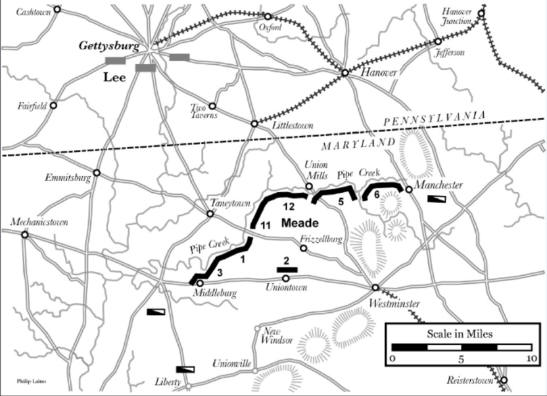Gettysburg: A twist of fate in the Civil War
David Buie
(7/2024) The Battle of Gettysburg, fought from July 1 to July 3, 1863, remains one of the most pivotal clashes in the American Civil War. Yet, history often overlooks the significant role Taneytown, Maryland, played in the events leading up to this momentous battle. Union General George Gordon Meade, newly appointed commander of the Army of the Potomac, originally envisioned a different strategy that could have shifted the battleground closer to Taneytown. As Gettysburg attracts thousands of tourists annually, Taneytown should seize this opportunity to highlight its historical importance and capitalize on the tourism dollars flowing into Gettysburg. Taneytown can transform its local culture and economy by leveraging its rich Civil War heritage.
General Meade's original plan, the Pipe Creek Circular, aimed to establish a solid defensive line along Pipe Creek in Maryland. This strategic move was designed to lure Confederate General Robert E. Lee into a more favorable position for the Union forces. If this plan had been executed, the central conflict might have occurred around Taneytown, making it a critical point in Meade's defensive strategy. Instead, campaign dynamics and Confederate movements led to the historic clash at Gettysburg, which naturally drew both armies due to its strategic geography and road network.

Today, Gettysburg's historical significance draws tourists worldwide, generating substantial revenue and fostering a thriving local economy. However, Taneytown's role in the Civil War remains a largely untapped resource that could significantly boost its economic prospects. By promoting its historical connection to the Battle of Gettysburg, Taneytown can attract Civil War enthusiasts, historians, and tourists eager to explore the broader narrative of the conflict.
On June 30, 1863, just before the Battle of Gettysburg, Meade positioned his troops south of Big Pipe Creek, preparing for a defensive stand against Lee's advancing forces. Corps commanders were assigned positions along this line by July 1. Taneytown was at the heart of these preparations, with Meade ordering his engineers to lay a defensive line along the high ground east of Big Pipe Creek from Manchester to Middleburg in Carroll County. This critical positioning highlighted Taneytown's strategic importance during the campaign.
Despite these plans, the Pipe Creek Line became a historical footnote. The Union's decision to advance to Gettysburg was influenced by General John Reynolds, who sought to defend his home state of Pennsylvania. Reynolds advanced his corps to Gettysburg, where he was killed on July 1, igniting a battle that Meade could not abandon. Over the next three days, intense fighting ensued at critical locations such as Devil's Den, Little Round Top, Cemetery Hill, and Culp's Hill, culminating in the disastrous Pickett's Charge on July 3, which led to a Confederate retreat.
If Meade's original plan had prevailed, the monumental battle and subsequent events, including President Lincoln's famous address, might have been associated with Taneytown. Imagine the historical and economic impact of the "Taneytown Address" instead of the Gettysburg Address. Such a reimagining underscores the potential Taneytown holds in Civil War history.
Taneytown's connection to these historical events provides a unique opportunity to attract tourists. The town can develop museums, guided tours, and educational programs focusing on Meade's strategic planning and the significance of the Pipe Creek Circular. Highlighting Taneytown's role can create a compelling narrative that complements the Gettysburg experience, offering tourists a broader understanding of the Civil War's intricacies.
The economic benefits of tapping into this tourism market are substantial. Increased visitor numbers can boost local businesses, create jobs, and generate revenue that can be reinvested in the community. Additionally, partnerships with Gettysburg's established tourism infrastructure can foster cross-promotion and shared events, enhancing the appeal of both locations.
To achieve this, Taneytown must actively market its historical significance. Collaborating with historians, Civil War reenactment groups, and tourism experts can help craft engaging and informative visitor experiences. Investment in infrastructure, such as interpretive centers and heritage trails, will further enhance Taneytown's appeal as a tourist destination.
Taneytown's growing population and the community's need for economic revitalization make this a timely and viable strategy. By embracing its historical legacy, Taneytown can ensure a prosperous future while honoring the sacrifices and strategic decisions that shaped American history.
Though often overshadowed by Gettysburg, Taneytown's role in the Civil War is vital to the conflict's story. By capitalizing on this heritage, Taneytown can draw tourism dollars, invigorate its local economy, and offer visitors a richer, more comprehensive understanding of the Civil War. Now is the time for Taneytown to step into the historical Spotlight and claim its rightful place alongside Gettysburg in the annals of American history.